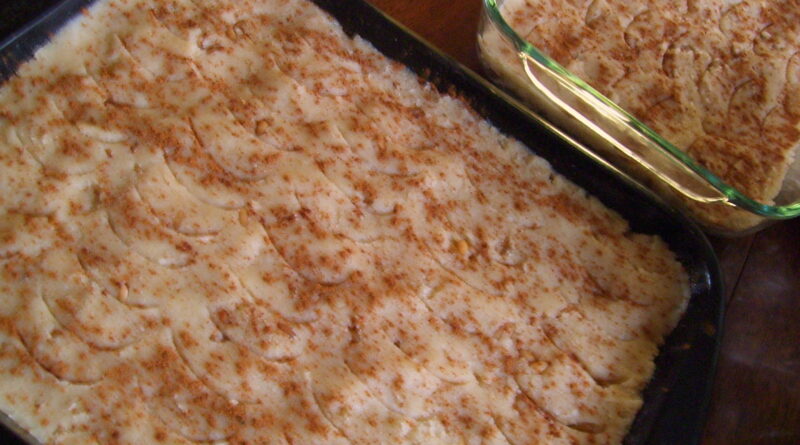Irmik helvası (Semolina halva)
Irmik Helvası (Semolina Halva): A Taste of Tradition and Sweet Memories
When it comes to classic desserts that have stood the test of time and continue to evoke nostalgia, few can compare to Irmik Helvası, also known as Semolina Halva. This beloved dessert, with its golden hue, fragrant aroma, and delightful texture, holds a special place in the hearts of many. In this journey through the world of Irmik Helvası, we will explore its rich history, the art of preparation, and the cultural significance of this delectable treat.
The Sweet Origins
Irmik Helvası has deep roots in the culinary traditions of Turkey and the Middle East, dating back centuries. The term “helva” itself has Arabic origins, meaning “sweet dish,” and it has been enjoyed in various forms across the region for generations.
The key ingredient in Irmik Helvası is semolina, a coarse wheat flour that gives the dessert its distinctive texture. Other essential components include sugar, butter or oil, and water or milk. Often, the dessert is infused with flavors like fragrant vanilla, aromatic cinnamon, or the subtle zest of citrus fruits.
The Simple Elegance of Ingredients
Semolina
Semolina is the star of the show in Irmik Helvası. It’s a versatile ingredient made from durum wheat and is known for its coarse texture. The semolina is toasted to a golden brown, imparting a nutty flavor and lovely color to the dessert.
Sugar
Sugar is what sweetens the halva, creating a delightful balance with the toasted semolina. The amount of sugar used can vary to suit personal taste, but it’s typically enough to create a pleasantly sweet treat.
Butter or Oil
Butter or oil is used to cook the semolina and create a rich, buttery flavor. While some traditional recipes use butter, others opt for vegetable oil to make the dessert dairy-free.
Liquid
Liquid is an essential element in Irmik Helvası, as it transforms the toasted semolina and sugar into a silky, cohesive dessert. Water, milk, or a combination of both can be used, with milk adding an extra layer of creaminess.
Flavorings
Flavorings like vanilla extract, cinnamon, and grated citrus zest are often added to enhance the taste and aroma of the halva.
Crafting the Perfect Irmik Helvası
The beauty of Irmik Helvası lies in its simplicity, but achieving the perfect balance of flavors and textures requires finesse. Here’s a step-by-step guide to crafting this timeless dessert:
Step 1: Toasting the Semolina
- Heat a heavy-bottomed pan over medium-low heat.
- Add the semolina and cook it, stirring constantly, until it turns a deep golden brown. This step is crucial for the nutty flavor and golden color of the halva.
Step 2: Preparing the Sugar Syrup
- In a separate pot, combine sugar and water or milk, along with any flavorings you desire (e.g., vanilla or cinnamon).
- Heat the mixture until the sugar dissolves completely, creating a sweet syrup.
Step 3: Combining the Semolina and Syrup
- Slowly pour the sugar syrup into the toasted semolina, stirring continuously to prevent lumps.
- Continue to cook and stir until the mixture thickens and starts to pull away from the sides of the pan.
Step 4: Adding Fat
- Stir in butter or oil, incorporating it into the halva until it becomes glossy and rich.
Step 5: Resting and Serving
- Remove the Irmik Helvası from heat and let it rest for a few minutes before serving.
- It can be shaped into individual portions, garnished with nuts or dried fruits, or served warm in bowls.
The Cultural Significance
Irmik Helvası is not just a dessert; it’s a symbol of hospitality and tradition in Turkish culture. It is commonly prepared for special occasions, such as weddings, religious holidays, and family gatherings. The act of making and sharing Irmik Helvası is a way to express love and care for guests and loved ones.
In some regions of Turkey, it is also a tradition to prepare Irmik Helvası when a new home is being built or a significant life event is celebrated. This sweet gesture is believed to bring good fortune and blessings to new beginnings.
Regional Variations
Just like any cherished dish, Irmik Helvası has regional variations that add unique twists to the classic recipe. Some regions may use different nuts or flavorings, such as mastic resin or rosewater, to create distinctive versions of this dessert.
In Greece, a similar dessert called “Ravani” is made with semolina, sugar, and yogurt, soaked in a fragrant syrup. It showcases the influence of neighboring culinary traditions.
Irmik Helvası Beyond Borders
While Irmik Helvası has deep roots in Turkish culture, its exquisite taste has earned it admirers around the world. As international cuisines become increasingly popular, you can now find variations of semolina halva in many countries, often with unique twists to suit local preferences.
In India, for instance, a dessert known as “Suji ka Halwa” is made using semolina, ghee (clarified butter), sugar, and a generous amount of cardamom for a burst of flavor.
Conclusion
Irmik Helvası, or semolina halva, embodies the heartwarming essence of tradition, hospitality, and sweet indulgence. Its simple yet elegant ingredients, preparation method, and cultural significance make it a beloved dessert that transcends borders.
As you savor a spoonful of Irmik Helvası, you are not just enjoying a delightful dessert but also partaking in a time-honored tradition that has been passed down through generations. Whether it’s shared at a joyous celebration or simply savored as a comforting treat, Irmik Helvası reminds us of the enduring power of food to bring people together and create sweet memories that last a lifetime.
